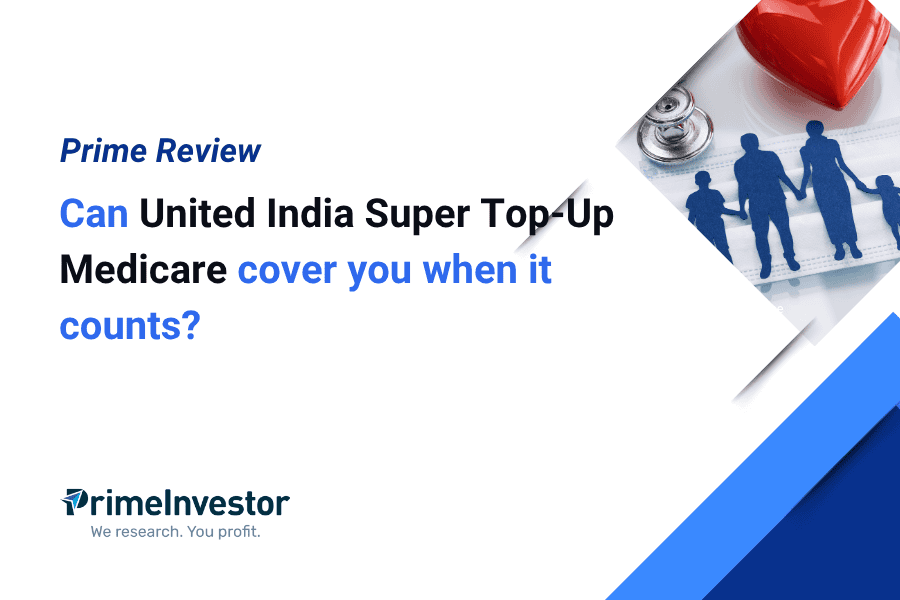Super top-up policies are a smart, cost-effective way to boost your health coverage without drastically increasing your premiums. These plans kick in after a certain threshold of medical expenses is crossed, offering high-value protection against major healthcare costs.

Super top-ups can also be used as a standalone plan to cover only high-value claims—reducing your premiums in exchange for agreeing to pay up to a certain amount out of pocket. We’ve explained this strategy here: Tired of rejected health claims? Here’s your escape plan – PrimeInvestor.
Today, we’ll look at a super top-up policy from a PSU insurer that offers generous options for both deductible and cover: United India Super Top Up Medicare Policy.
Super top-up
Let’s quickly refresh what a super top-up policy is. Unlike a basic health insurance policy, super top-ups come with a deductible—a fixed amount which you are expected to foot out of your own pocket in a policy year. Once your total hospitalisation costs in the policy year cross this deductible, the super top-up kicks in and works like any regular policy for the rest of that policy year.
One thing to note is that many super top up policies only offer reimbursement of hospitalisation expenses after the treatment. They do not provide cashless benefits while you are undergoing treatment.
United India Super Top Up – Policy features
Let’s take a look at the key features of this policy.
About the insurer: United India Insurance Company Limited is a public sector insurer. It works with several third-party administrators (TPAs) to manage claims. As per FY24 disclosures, its claim ratios are in line with the industry average. Its claim settlement by value, by number, and its claim settlement efficiency (i.e. the percentage of claims settled within 3 months) are:
- 79.98%, 90.07%, and 98.1% respectively.
- For comparison, the industry average stands at 79.82%, 88.64%, and 98.06%.
Where United India does stand out is in the complaints metric—total complaints registered per 10,000 claims. For United India, this number is 13, compared to the industry average of 30.
Basic features and coverage
United India Super Top Up Medicare is available as both individual and floater plans. Anyone aged 18 to 65 can purchase it. Children aged at least 91 days can be added to the policy. Like a standard health insurance policy, this super top-up covers:
- Hospitalisation: Admission to a hospital for at least 24 hours for treatments or procedures.
- Day care treatments: Procedures that earlier required hospitalisation but can now be done within a day, thanks to medical advancements.
It also covers pre- and post-hospitalisation expenses. However, the duration depends on the sum insured:
- For sum insured below Rs.10 lakh: 30 days (pre) and 60 days (post).
- For sum insured Rs.10 lakh and above: 60 days (pre) and 90 days (post).
Since this is a super top-up plan, there’s little reason to opt for a sum insured below Rs.10 lakh. Even so, the 60/90-day period isn’t the best in the market.
Deductibles and sum insured
If you have a base policy with a cover ranging from Rs.5 lakh to Rs.25 lakh and are considering increasing it, the United India Super Top Up Medicare offers a wide range of options to increase the cover up to Rs.1 crore. The combination of deductible and sum insured options offered by this policy is quite comprehensive compared to what peers offer.
For example, if you choose a deductible of Rs.5 lakh or more, you can get cover up to Rs.1 crore. Today, with rising medical costs, a base health cover of at least Rs.5 lakh is essential. The table below shows the various combinations of deductibles and cover that this super top up policy offers.
For those combining this super top up policy with a base plan, the flexible options for deductible and sum insured should meet your needs. However, if you’re thinking of skipping a base policy and hope to keep your deductible low (less than Rs.5 lakh) while buying a super top-up, this plan won’t work for you.
Source: Policy wordings
Premiums
Below are the sample premiums for an individual or a family of 4 (2 adults + 2 kids), for a sum insured of Rs.20 lakh and a deductible of Rs.5 lakh. Compared to private insurers, the United India Super Top Up Medicare falls on the expensive side for the sample cases we checked.
Do note that these premiums are indicative, based on published rates. Actual premiums may vary. For the full premium list, refer to the Premium Table.
Policy minuses
Before we get to whether United India Super Top Up Medicare is worth considering, here are a few key limitations to keep in mind.
- No restore benefit: Most base health insurance plans come with a restore benefit, a feature that reinstates your cover if it gets used up due to a claim within a year. Super top-ups do not offer this facility. This super top up plan is no exception. That means you’ll need to pick a sum insured high enough to handle all possible high-cost claims, especially if you’re buying a floater policy (where one cover is shared among multiple family members).
- Longer waiting periods: The waiting period for most pre-existing diseases (PEDs) is 3 years, which is the maximum allowed under current regulations. In comparison, many private insurers offer shorter PED waiting periods of 1 or 2 years. But 3-year PED waiting periods are common among PSU insurers.
- Exclusions: The policy excludes several treatments and conditions, including expenses related to diagnosis and evaluation, obesity or weight control treatments, injuries from hazardous or adventure sports, sterility and infertility treatments, maternity expenses, and congenital external diseases among others. (To view the full list of exclusions, refer to the policy wordings (page 10)). That said, these exclusions are fairly standard across most health insurance policies.
Sublimits and copayments
United India Super Top Up Medicare does not have a copayment clause or sub-limits on room charges. However, it does apply sub-limits on specific treatments. For example:
- Balloon sinuplasty: limited to Rs.1 lakh
- Oral chemotherapy: Rs.2 lakh
- Green laser treatment: Rs.2 lakh
It also imposes a blanket cap on all robotic surgeries:
- Rs.10 lakh for surgeries involving the central nervous system
- Rs.5 lakh for all other robotic surgeries. Given that many common surgeries today incorporate robotics, this can be a big constraint.
You can find the full list in the policy wordings (page 9).
These hard caps are a major drawback, especially when you consider that medical costs continue to rise, and newer treatments may adopt robotic procedures in the future.
For a super top-up policy, which is meant to handle large medical expenses, such low limits on certain modern treatments are a red flag—especially for those planning to hold the policy long-term.
Who should consider this policy?
PSU insurers are usually better at claims settlement than many private insurers. United India has decent claim settlement performance and a low complaint ratio.
On the plus side, United India Super Top Up Medicare does not have the room sub limits that are usually a constraint to plans from PSU insurers. It also offers higher super topup cover than is the case usually with PSU insurers. However, the sub limit on robotic surgeries is a key drawback for buyers across age groups, as many surgical procedures now use robotics. These hard limits, in our view, negate the other positives of the United India policy.
The policy may only suit older individuals in the 50-65 age group. For older individuals, finding a base policy with affordable premiums is a hard task; the generous cover and flexibility in deductibles that this super top policy offers along with the insurer’s good claims settlement record make it a reasonable back-up for seniors.
The policy also offers a 10% online discount. But don’t let that be the sole reason to buy it directly. In the event of a claim, having support from an experienced agent can make a difference.




8 thoughts on “Prime Review: Can United India Super Top-Up Medicare Cover You When It Counts?”
Sir my age is 50,but my premium paying capacity is low, I have two kids below 5 years. I am confused, Kindly suggest the future course of action in view of above review please.
Hello Sir,
If you don’t have a health insurance policy currently, you may consider starting with a basic policy. However, if you find the premium for a basic policy too high, you can look at a super top-up policy like this one as a backup option. You may also check whether your employer provides health cover that allows adding family members to the policy.
Do note that a super top-up policy alone will not help for low-value claims, but it can offer protection against high-value claims at an affordable premium.
Regards,
1. Is it good to buy a policy through an agent? I don’t think they will assist in talking to Health insurance company and sort any medical claim during hospitalisation
2. Public sector health insurance policies have restrictive limits, whereas private sector focuses on profits , is there any unique to balance both?
3. Any view on SBI health insurance?
1. There are agents who help with claims and communications. It may be better to check this in advance.
2. There is no one size fits solution that is applicable for everyone. The below articles may help
https://primeinvestor.in/reports/health-insurance-claims-settlement/
https://primeinvestor.in/reports/rejected-health-claims-escape-plan/
3. As of now, we haven’t reviewed any policies from SBI
Regards
Hey
> Excluded Providers:
Didn’t IRDAI or a court issued a ruling or guideline that for medical care customers are not supposed to check the list of “not okay” hospitals esp. during emergencies? (Not sure about this though)
> Hazardous or Adventure sports (Code- Excl09): Expenses related to any treatment necessitated due to
participation as a professional in hazardous or adventure sports, including but not limited to, para-jumping,
rock climbing, mountaineering, rafting, motor racing, horse racing or scuba diving, hand gliding, sky diving,
deep-sea diving.
What does this “not limited to” means? Is it up to their discretion? What sports are defined as hazardous? Does IRDAI have a list?
By the way, this policy has way too many “limits”. I guess it’s good for the people who are finding it difficult to get a policy and these folks are willing to provide one.
Hello,
Delisted hospitals: I’m not aware of any specific IRDAI ruling regarding insurance claims for treatment at delisted hospitals. In general, insurers do allow claims in life-threatening situations. However, even in such cases, the entire claim may not be approved.
Hazardous or adventure sports: The list—along with the phrase “including but not limited to”—is part of IRDAI’s standardised exclusion guidelines 🙂 Please see here: https://irdai.gov.in/document-detail?documentId=392498. I’d interpret it to mean any sport or leisure activity involving significant risk, even if it’s not explicitly mentioned. So yes, it could be at the insurer’s discretion.
Regards
Also, the exclusion applies only to “participation as a professional”, right? So, if a software engineer or a financial analyst or a doctor etc. get injured doing any of the listed activities, are they covered?
Good question. The IRDAI’s standardized exclusions do state that participation as a professional is excluded. However, this detail may not always appear in the fine print of individual policies. It is mentioned in this policy, but here’s an example where it is absent:
https://www.nivabupa.com/health-insurance-articles/all-about-health-insurance-exclusion-list-updated-from-irdai.html
To be conservative, it’s safe to assume that any related costs may not be covered. That said, there is scope for escalation in such cases, based on IRDAI guidelines.
Regards